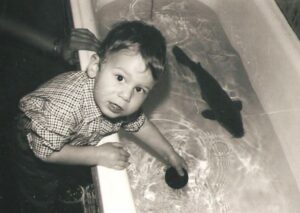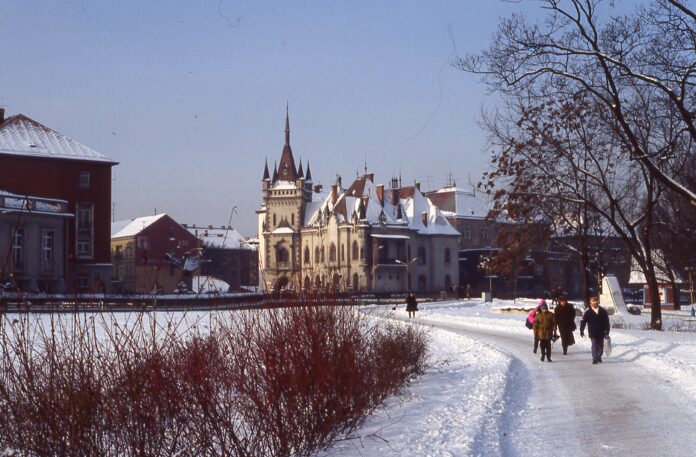
Previously: 40 Years in Beer, Part Thirty Seven: Andy, the Tatras, Magic Johnson and Mamut.
Communism in Czechoslovakia lasted from 1948 through 1989, when the “velvet” revolution,” abetted by Mikhail Gorbachev’s geopolitical indifference, produced great change.
Shortly thereafter, the dissident Czech writer and playwright Václav Havel was chosen president. It was a stunning development by any measure, seeing as Havel, a humanist and intellectual, had been imprisoned only months earlier.

Long denied the opportunity to work in his chosen field of theater arts as punishment for “anti-state” activities, Havel in effect was subject to internal exile for the better part of two decades, at one point finding employment in the countryside as a laborer at the Pivovar Krakonoš in Trutnov.
(As an aside, allow me to suggest that obvious negatives aside, at least the fringe benefits of brewery work tasted quite good.)
Havel’s play Audience was inspired by this experience, written as a dialogue between an urban playwright and a rural brewmaster, the latter prone to drinking heavily on the job, and drifting in and out of lucidity during their conversations.

Having ascended to “the castle” (Castle Hill in Prague, the seat of government), Havel’s immediate concern was the Czechoslovak economy, because his inexperienced team faced an unprecedented task, in short: While there was an existing communist template for seizing the means of production, what about reversing the process and restoring capitalism?
The intrinsic absurdities and stagnation of the outmoded Soviet-style system were evident to most, with more than 95% of all economic activity controlled by the Czechoslovak state. Things needed to change quickly lest the post-communist country fall further behind, but how to institute change without exacerbating human misery and risking societal chaos?
To greater or lesser degree, all the former Soviet bloc nations created programs of privatization designed to quantify the value of state-held assets through vouchers (or shares), suitable for buying, selling or swapping by ordinary citizens, who otherwise lacked the resources to invest or borrow in the absence of a banking system as we tend to understand it in the West.
The privatization process was complicated by an obligation to make restitution for assets and properties that had been absorbed by the communists (and in many cases, the Nazis preceding them) or, when possible, to return them to their rightful owners.
It soon became obvious that the only citizens who possessed sufficient capital to accumulate or purchase vouchers were the ex-communists themselves. The process was messy and divisive, and yet the transformation eventually was achieved.

I mention the privatization process because it was a constant accompaniment to my stay in Košice, continuing into the period when Czechoslovakia split into separate entities in 1993 (today, both Czech Republic and Slovakia are members of the European Union).
First we’d see an auction notification posted on a wall or window, and then a restaurant or shop formerly administered by the state would be sold, renovated and reopened, or barring a sale, closed for good.
Concurrently, a kiosk would materialize somewhere on a street corner and pop-up commerce commence, either representing the aforementioned ill-gotten booty wielded by ex-communists, or composed of hard cash returning home from the Czechoslovak diaspora abroad.
—
On Hlavná Street near the Cathedral of St. Elizabeth there was one such “business” struggling to survive in privatization limbo, an eatery with an interior vaguely reminiscent of the scene in Edward Hopper’s “Nighthawks” painting, albeit without huge windows facing the street.
I’d walked past it often but only peeked inside, concluding that the “open” arrangement of stainless steel and tile had resulted from a 1970s-era functionary’s unsuccessful attempt to conjure his brief encounter with American cinema (or White Castle) into real world design. Standard issue communist kitsch managed to survive in this instance, though not without a challenge.
In turn, the existence of this quasi-retro communist diner helps to explain why LaVega Parker ran up to me one day outside our building on Považská Street, panting, with a big grin on his face.
“The diner has chicken-fried steak!”
LaVega was a Texan and a pastor, not necessarily in that order, and I thought perhaps he’d just preached a particularly agitated sermon. Like me, LaVega was on temporary assignment in East Slovakia, except that his mandate was spreading the gospel in a locale that only recently had been officially hostile to efforts like his.
Along with his friend and fellow minister Jennings (or “Jenn”; I can’t recall his family name, but recall that he hailed from Wyoming), LaVega was quartered at the “hospital hotel”
I wasn’t openly skeptical to his face, but to be honest, it struck me as doubtful that the diner really served chicken-fried steak, which in the tradition of the American South is tenderized beef steak breaded like fried chicken, often doused in a white gravy.
At the same time, the analogy was perfectly plausible given the Central European tradition of schnitzel, or breaded and pan-fried pork (and less commonly, veal).
LaVega and I agreed to meet at the “diner” the following week, but unfortunately Privatization Hour Zero had arrived, and the doors were found to be permanently locked.

I believe the entrée in question probably was a Slovak dish called Shepherd’s Steak (Bačovský Rezeň), with the “gravy” a sauce of sour cream and cheese, tasty though not precisely suitable for dumping over biscuits at breakfast.
LaVega and Jenn were affable fellows, and perhaps owing to our mutual pre-internet isolation, they weren’t overbearing when it came to their Christianity and my atheism.
Soon after their arrival in Košice a young local man named Jan K. came to act as a hospital-approved factotum for the American contingent. He had converted to their brand of religion, and at some point thereafter took it a step further and decamped for America.
I’ve lost touch with all of the aforementioned fellow travelers, but they always come back to mind during the holidays, when I drink a brief toast: “To all of you and those amazing times, gentlemen.”
—
Meanwhile in Prague, President Havel focused his interpretive powers on matters of conscience and consciousness, which he perceived as vital to Czechoslovakia at a fundamentally human level.
He persistently reminded his countrymen that privatization or any other program of post-communist reform would have little chance of succeeding without an examination of the society’s daily psychological assumptions.
Havel theorized that the chief legacy of communism was a trauma at the grassroots core of Czechoslovak society, something that had despoiled the very nature of daily interaction between friends, lovers, neighbors and co-workers.
Persistent indoctrination in the ideology of class warfare had turned all human relationships inside out, and the cynicism of everyday reality, as it operated far apart from the panaceas of official propaganda, subverted all aspects of trust, caring and hope.

After all, Havel was an intellectual. His office was primarily symbolic, and his political legacy ineffectual. The loftiness of his musings often clashed with mundane daily needs on the part of the populace, like reliable heat in winter and an escalating in disparity between prices and pay scales.
Nonetheless, as Christmas approached in 1991, and whether lofty or lowbrow, these were the topics of intense discussion among my Slovak students.
Would the reintroduction of capitalism make the situation better or worse? How fast should change ideally be? How do we reintegrate into Europe? No one really knew the answers, least of all me. My primary concern was directing these chats in English, as opposed to Slovak.
Concurrently, I was 31 years old and for my entire life had spent the Christmas holidays at home. Playing very much against type, I found it oddly disconcerting to be away for the first time.
Although the notion of submitting “guest” columns to the New Albany Tribune had long since been abandoned, I continued to write, including a Christmas essay to be saved for future reference. Here it is, lightly edited but substantially as written in late 1991.
—
A Christmas Dispatch from Slovakia

There’s a good chance of a “White Christmas” in Slovakia.
The winter’s first snow has come and gone, and although we didn’t get very much, it was enough to add a cheerful hazard for pedestrians in the forms of sleds, multitudes of them, some of old‑fashioned wood construction, others of molded plastic.
More sleds than I’ve ever seen have appeared as if by magic from closets and storage rooms, to be pulled by their brightly outfitted young owners and steered at breakneck speed down any and all available slopes, inhabited or otherwise.
They had been charging down the wide sidewalk that leads from Festival Square and ascends the low ridge to the hospital complex where I teach, and the snow on the walkway had been firmly packed into an icy surface that defied sure footing, and the reason I know all this is because I was trying to walk up the hill – and faring miserably.
You can’t blame the children for failing to understand (or to care about) the consequences of their fun. After all, children don’t have as far to fall as 6’ 4” visiting Americans.
 It was a good day for a walk. The snow was fresh and powdery, and it crunched loudly beneath my boots. The white dusting on the cupolas and steeples of the old city brightened the sooty, aging facades. Even the look-alike gray rows of “rabbit hutch” block housing were softened by the white.
It was a good day for a walk. The snow was fresh and powdery, and it crunched loudly beneath my boots. The white dusting on the cupolas and steeples of the old city brightened the sooty, aging facades. Even the look-alike gray rows of “rabbit hutch” block housing were softened by the white.
The sunshine was bright and surface temperatures no lower than freezing, but a sharp, gusting wind from the north kicked up miniature snow squalls and blew the clothes on the ubiquitous clotheslines into weird, frozen, horizontal positions.
The chill made me think of Russia. The Soviet Union used to lie close to Košice, but now the line on the obsolete map is the border of the infant Ukrainian republic, and who knows the procedure for crossing that border?
Probably a bottle of Scotch and a smile.
The cold flowing into Košice from Siberia will be as near as I come to Russia on this trip, yet I can still see our fur‑clad, vodka‑wielding, erstwhile enemies waiting in line for brown bread.
It makes me think of the Cold War’s cruel 40-year toll: Malnutrition, homelessness, environmental degradation, social upheaval, rampant violence, the decay of the family, impending economic catastrophe ‑‑ and these are just America’s spoils of “victory.”
In the former U.S.S.R., the situation is even worse.
But Christmas is coming, and somewhere in a valley near Košice, in the backyard of a quaint farm, a goose is getting fat.
Barrels are being inspected to gauge the progress of the cured cabbage that will form the base of the traditional holiday soup. A trip to a nearby town is being planned. There will be shopping for gifts and a visit to the fish market for pond-raised carp, another holiday staple ‑‑ or perhaps the delicacy will be vended from oversized blue plastic tubs.

For an American, there’s an eerie quality to the Christmas season in Slovakia. For starters, decorations didn’t begin to appear until the first week of December; then again, what can you expect of such an unenlightened country where there’s no contrived holiday like Halloween to mark the beginning of the yuletide shopping season?
Only a few tasteful, understated window displays are to be seen in the stores, and high pressure, guilt‑laced sales tactics aren’t in evidence at all. Slovakia obviously has much to learn about economics before its people can begin to see the wisdom of centering all hopes on wild overspending at Christmas in order to keep the economy afloat.
In Slovakia, Santa Claus makes his rounds on the eve of St. Nicholas Day (December 6). Children scrub and polish their shoes and place them on the windowsill to be filled with candy and chocolate, but only if they’ve been good.
If not, they’re supposed to receive a bundle of twigs bound together and intended for use to swat their you‑know‑what. On Christmas Eve, rumor has it that gifts are not delivered by Santa, but by Jesus himself.
The savior’s involvement would have been whispered in Communist times, when the secular regime attempted to persuade the populace that a chap named Grandfather Frost brought the goodies, presumably on behalf of the benevolent party leadership.
There are Christmas trees and caroling in the streets by children, one of whom might carry a representation of the manger, and maybe the singers will be rewarded for their efforts with fruit and cookies.
In short, despite tight economic times and a full list of daunting problems to be solved, the holiday season in Košice is proceeding according to schedule and tradition. I’ve been given a bottle of homemade peach brandy for St. Nicholas Day; the doctor who distilled it (!) instructed me to make a Christmas Eve toast to peace, health and a good harvest.
On a cold day, with steaming sauerkraut soup and carp filets just around the corner, the toast strikes me as a true and noble thought.
(end 1991 dispatch)
—
Those big blue plastic tubs appearing just before Christmas piqued my curiosity, especially when I saw fish swimming in them. My students gleefully explained: those aren’t mere fish, they’re kapr, “carp” to Americans, and they’re not just carp — they’re Christmas dinner!
Three students invited me into their homes for Christmas Eve (one) and Christmas Day (two). They stocked up on beer, and food was plentiful, with all three households serving fried carp, which as you might imagine remains a hall-of-fame culinary memory.

Why do Central Europeans in general, and Czech and Slovaks in particular, eat carp for Christmas?
Some say the practice owes to old-fashioned rituals of Catholic fasting, while others point to the long tradition of aquaculture, or freshwater fishponds, in places like Southern Bohemia (Czech Republic). Another explanation is the lower price point of carp, compared to beef or pork.
Not unexpectedly, there’s more to the story, because bottom-feeders need their baths, too. When selecting a carp from the barrel, it is possible to kill, prepare, weigh, wrap and pay for the fish right there, on the spot.
But more commonly, sidewalk carp shopping is strictly BYOB – bring your own bucket. According to tradition, families transport their chosen carp to the bathtub back home to undergo a few days of freshwater internal cleaning (for the carp; presumably, humans go without bathing during this time).
Consequently, while Americans with a taste for history might be familiar with our national legacy of bathtub gin, the notion of bathtub carp is very different.

In modern times, the carp usually is fried and accompanied by a mayonnaise-based potato salad, which was my delightful dining experience in 1991. I also was served cabbage soup, and for dessert, bobalki, or honey-sweetened balls of baked dough with poppy seeds.
After my meals on Christmas Eve and Christmas Day, I’d had enough in terms of caloric intake, although by Boxing Day my students probably were happily eating peppery carp soup prepared with the remnants of the previous main course.
(As with the fantastic soup from neighboring Hungary prepared with carp from Lake Balaton, slurp it carefully, because mud dwellers are quite bony.)
According to numerous sources, the Christmas carp tradition in places like Slovakia and Czech Republic is waning considerably, or at the very least evolving with the advent of frozen options.
Other reasons include an overall higher standard of living, and with it a taste for Christmas turkey or red meat, as well as the main two drawbacks of bringing living fish into your home to occupy the bathtub: your children might fall in love with the carp, and if not, the skill set necessary to clean and filet the fish has been lost, anyway.
For an overview of Slovak traditions at Christmas, go here. In retrospect, my sole Christmas in Košice mirrored all the other ongoing, transitional aspects of life in Czechoslovakia at the time, in the sense that it, too, was an amalgam of responses and adaptations to the aftermath of the communist era.
Don’t believe me? Then tell it to Grandfather Frost.
Next: 40 Years in Beer, Part Thirty Nine: I’m off to Spijkenisse with a beer list in my hand (1992).
—
* The photos below were taken during an autumn excursion with LaVega (pictured), Jenn and Jan from Košice to the towns of Levoča and Spišské Podhradie, including the latter’s major attraction, Spiš Castle.















































[…] Next: 40 Years in Beer, Part Thirty Eight: Christmas in Košice, 1991. […]
[…] 40 Years in Beer, Part Thirty Eight: Christmas in Košice, 1991 […]
[…] Previously: 40 Years in Beer, Part Thirty Eight: Christmas in Košice, 1991. […]
Comments are closed.